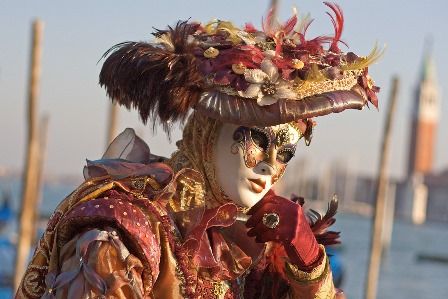
WTI Magazine #53 2015 February, 6
Author : folclore.it Translation by:
A timeless journey between the "fields" and water channels, including masks, wigs, cosmetics, sequins ... an enchanted, ancient and unreal location: the Carnival of Venice. Visitors to Venice during the carnival are involved in this very special atmosphere, where everything gets nostalgic and charming.
The Venice Carnival is one of the oldest carnivals and already in the XIII century it was declared a public holiday. By participating in disguise at the party, with everybody's faces hidden by masks, for a few weeks a distortion of everyday life and a leveling of social roles were created. Out of nowhere came a true artisan tradition that created beautiful masks of papier mache, plaster, clay and gauze, and even today, at any time of the year, these products can be purchased in Venice.
The arrival of the Carnival is introduced by the parade along the Grand Canal in a wonderful and sparkling procession with colorful masks; while another procession, this time silent and made by gondolas, skimming the water by candlelight, called "La Volgata del silenzio" (the Vulgate of silence), gives the farewell to the Carnival on Mardi Gras.
Between the two events, days of celebration take place with shows and dances in the private rooms of the ancient palaces, dances and concerts in the public squares, and many other fun moments.
At noon on the first Sunday of celebration, a tradition is "Il Volo dell'Angelo" (the flight of the Angel), originally called "Il Volo di Colombina" (Colombina is a typical and traditional Venetian character): a guest, a famous artist or an athlete, every year different and special, who comes down from the bell tower, secured to a metal cable, falling slowly to the ground, and through the crowded square.



